Louisiana, also known as the Pelican State or the Bayou State, is incredibly biodiverse thanks to its comfortably subtropical climate and wide range of habitats like vast swamps, lush forests, and even expansive prairies. Many unique turtles call this state home, from terrestrial tortoises to numerous freshwater turtles and even endangered sea turtles! Below, we’ll take an in-depth look at 8 of Louisiana’s most fascinating turtle species.
1. Common Snapping Turtle (Chelydra serpentina)
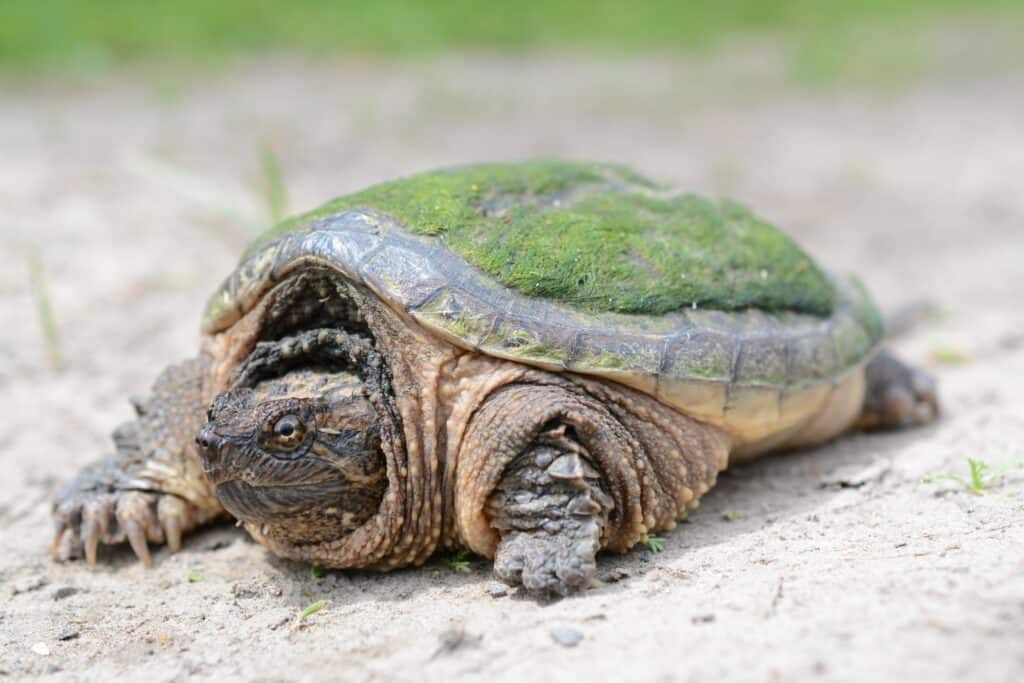
Common snapping turtles are one of the largest turtles in Louisiana.
©Trevor Meunier/Shutterstock.com
As one of North America’s most abundant, hardy, and widespread turtle species, it’s no surprise that the common snapping turtle also lives in Louisiana. In fact, these turtles live throughout the entire state in various freshwater habitats! However, they prefer shallow ponds, marshes, and streams with soft, muddy bottoms and lots of aquatic vegetation.
The common snapping turtle is one of the easiest turtles on this list to identify thanks to its distinct appearance and substantial size. Measuring 10 to 18 inches long and weighing anywhere from 10 to 40+ pounds on average, it is among Louisiana’s largest turtles.
This species’ scientific name, serpentina, refers to its surprisingly long and flexible neck. The turtle typically keeps its neck tucked into its shell unless it is hunting prey or biting in self-defense. Its head is wide and bulky with a sharp, strong, beak-like mouth. Its dark greyish-brown carapace is craggy, uneven, and often covered in a thick layer of algae and mud.
2. Kemp’s Ridley Sea Turtle (Lepidochelys kempii)
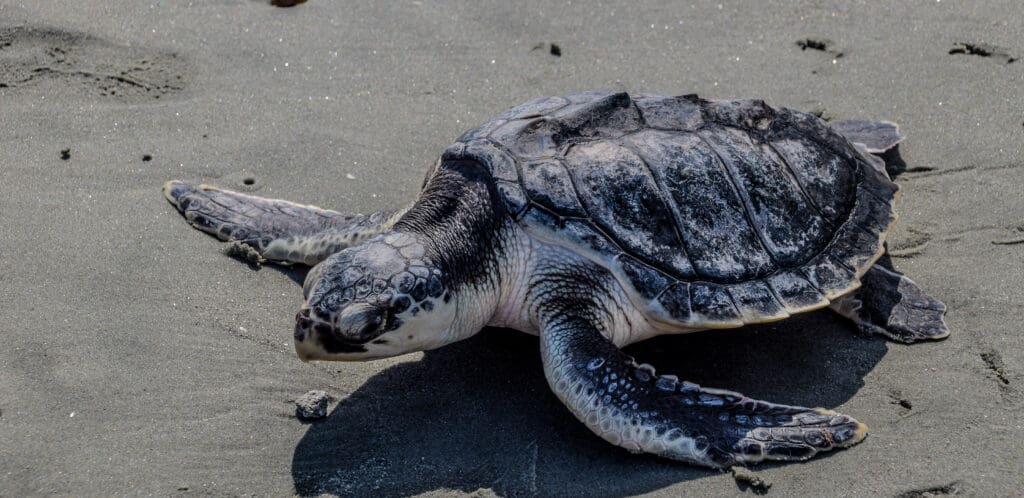
The smallest and rarest species of sea turtle is the Kemp’s Ridley.
©Prentiss Findlay/Shutterstock.com
Of the seven total living sea turtle species, the Kemp’s Ridley sea turtle is the smallest. It’s also the rarest, and, sadly, the most endangered of the bunch. It averages 22 to 28 inches long and weighs around 80 to 100 pounds. This is large by turtle standards overall but very small for a sea turtle. Interestingly, their skin and shells change color as they age, shifting from a dark purple as hatchlings to a pale grayish-green upon reaching adulthood.
Despite primarily living in the Gulf of Mexico’s waters, Kemp’s Ridley turtles haven’t actually nested on Louisiana’s shores for the past 75 years or so–until very recently, anyway. In 2022, several Kemp’s Ridley hatchlings were spotted along Louisiana’s Chandeleur Islands around 75 miles east of New Orleans. Over the course of the summer, dozens of turtle crawls were documented for the species along the 50-mile island chain!
In addition to being smaller and rarer than all other sea turtle species, Kemp’s Ridley sea turtles are notable for being the only sea turtles to nest during the day rather than at night.
3. Gopher Tortoise (Gopherus polyphemus)
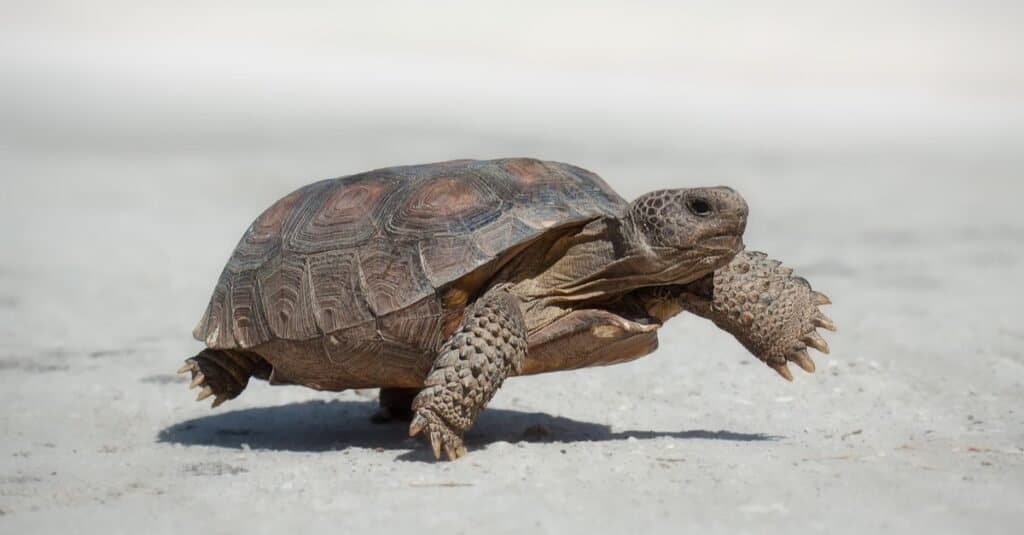
The gopher tortoise is a threatened species in Louisiana.
©Kristian Bell/Shutterstock.com
Native to the southeastern United States, the gopher tortoise is one of North America’s only native tortoise species. Its geographic range covers most of Florida as well as southern Georgia, Alabama, Mississippi, and just a handful of counties in southeastern Louisiana. It’s currently listed as threatened in the Bayou State. This is mainly due to habitat loss and illegal removals for the exotic pet and food trades.
As a fully terrestrial species, the gopher tortoise has a large, bulky build. Its wide limbs are very strong and rugged for digging expansive burrows. Its tan to dark brown carapace has a dome shape that is somewhat flatter than those of most tortoises, being much longer than it is tall. Most individuals average 7 to 10 inches long, though a carapace length of up to 15 inches is also common. The species’ average weight varies from around 5 to 13 pounds, with females being slightly larger than males.
Incredibly, gopher tortoise burrows can be up to 10 feet deep and almost 50 feet long! These massive networks of tunnels provide habitats for hundreds of other animal species, including frogs, snakes, and even burrowing owls.
4. Smooth Softshell Turtle (Apalone mutica)
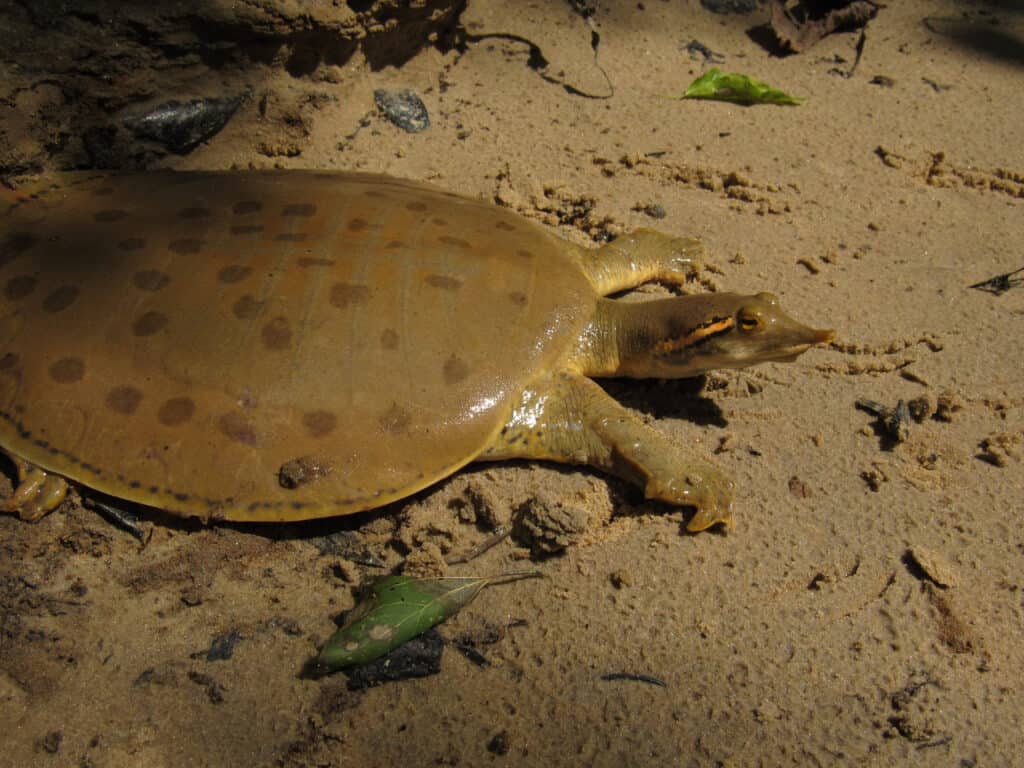
Smooth softshell turtles have a smooth carapace which is completely flat.
©Gabbie Berry/Shutterstock.com
The smooth softshell turtle is another one of the more easily recognizable species on this list thanks to its extremely distinct and rather bizarre appearance. It ranges from about 5 to 15 inches long, with females of the species being much longer and larger than males. It is easy to tell it apart from the very similar spiny softshell species by the lack of spines along the edges of its carapace.
True to its name, its greyish-brown shell is flat and completely leathery-smooth rather than dome-like and rigid like those of most other turtles. The shell also completely lacks defined scutes, or individual scales. But its strange physical attributes don’t stop there! It also has an unusually long neck and a very long, thin, snorkel-like snout. This helps it stay underwater for long periods of time while waiting to ambush aquatic prey like fish, insects, and amphibians.
This unique turtle species’ geographic range covers much of the American Midwest and Southeast. It lives throughout the entire state of Louisiana in various freshwater habitats. However, it prefers fast-moving streams and rivers with sandy or muddy bottoms.
5. Ouachita Map Turtle (Graptemys ouachitensis)
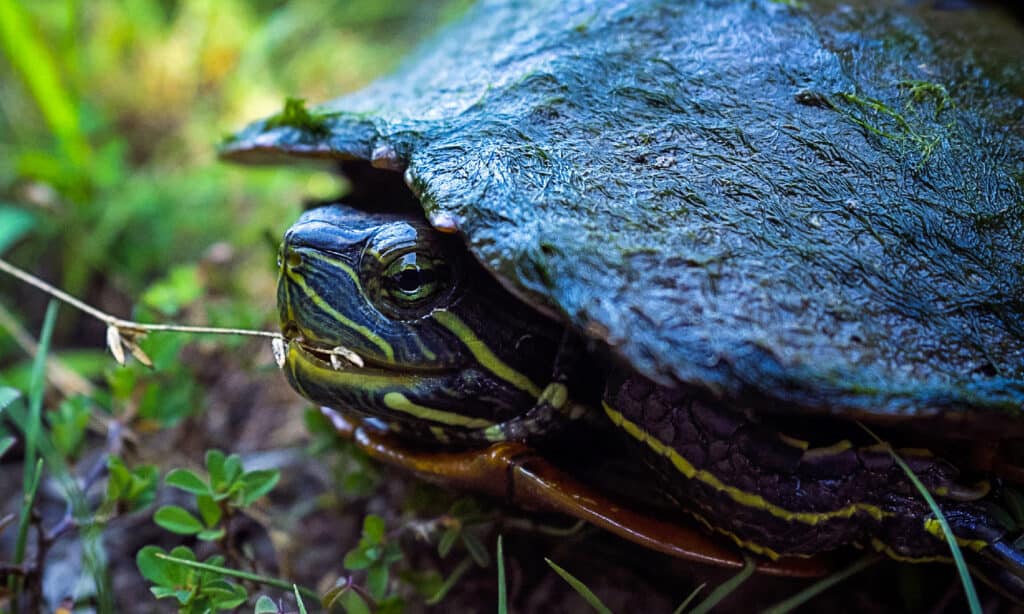
Ouachita map turtles get their name from the thin lines on their shell which resemble contour lines.
©Stephanie’screativeImages/Shutterstock.com
The Ouachita map turtle is one of around 15 different species of map turtles. These unique turtles get their name from the many thin, intricate webbing-like lines on their shells that resemble contour lines on a map. The other half of this particular species’ name comes from the Ouachita Mountains stretching across Arkansas and Oklahoma, though its geographic range extends well beyond this area into much of the surrounding American Midwest.
Ouachita map turtles are highly sexually dimorphic, with females being much larger than males. While males of the species tend to cap out at around 5 inches, females can reach up to 10 inches in length. Both sexes have a light brown carapace with a raised, serrated dark brown ridge stretching lengthwise down its center. Most individuals have small light yellow spots behind the eyes and along either side of the jaws.
Because they are highly aquatic and very small in size, it is rare to spot Ouachita map turtles on land. However, they do still leave their freshwater river and stream habitats on occasion to bask, mate, and nest.
6. Loggerhead Musk Turtle (Sternotherus minor)
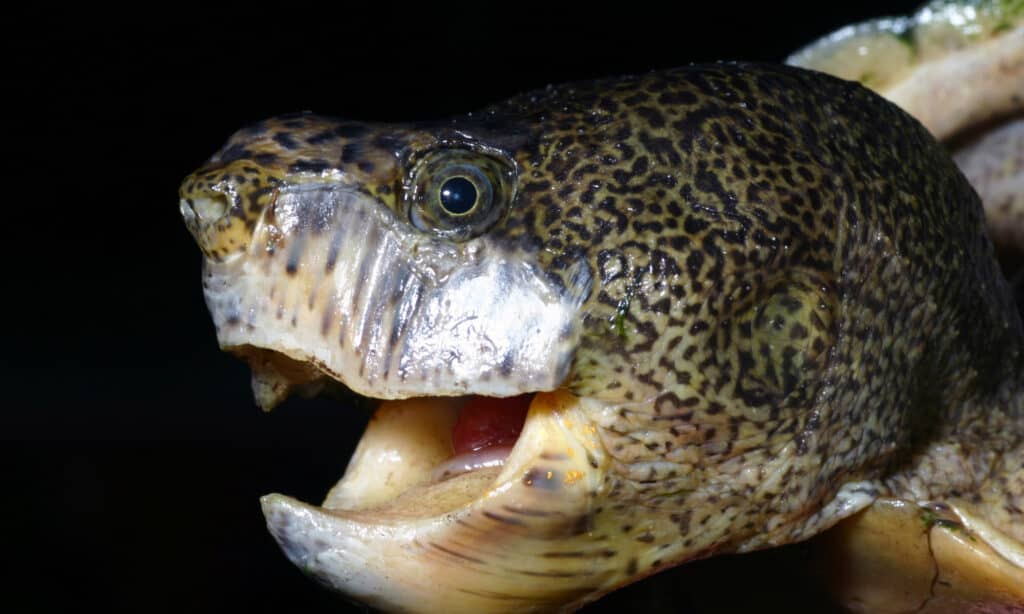
Loggerhead musk turtles have bulky heads with strong, powerful jaws.
©Michael Benard/Shutterstock.com
Not to be confused with the loggerhead sea turtle, the loggerhead musk turtle is a very small freshwater species. Despite its small size at just 3 to 5 inches long, though, it has a very wide, bulky head with surprisingly strong jaws, hence its common name. Its light yellowish skin is covered with lots of small dark greenish-brown splotches and lines. It has a short yet pointy, triangular snout.
This species’ geographic range mainly covers the southeastern United States. In particular, loggerhead musk turtles live throughout northern Florida, Georgia, Alabama, Mississippi, and southeastern Louisiana. They prefer clean freshwater habitats like streams, rivers, and springs with large mollusk populations and soft sandy or muddy bottoms.
Similar to the aforementioned Ouachita map turtle, loggerhead musk turtles have a raised, serrated ridge stretching lengthwise down their shells. This ridge is more pronounced in juveniles, though, and it tends to become less prominent with age.
7. Eastern River Cooter (Pseudemys concinna concinna)
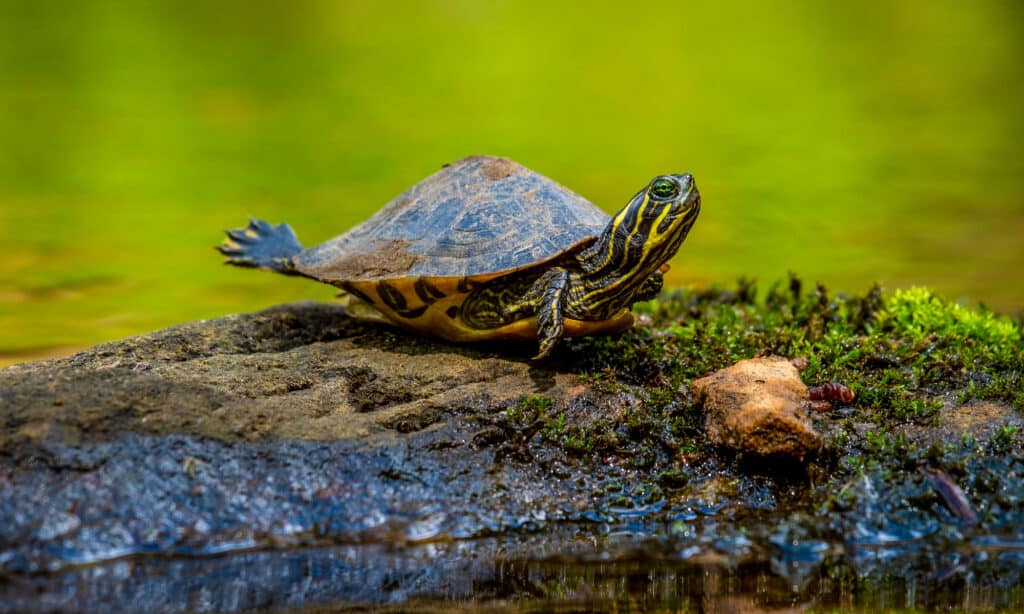
Eastern river cooters are a subspecies of the river cooter turtle and live in shallow freshwaters habitats.
©samray/Shutterstock.com
The river cooter turtle has two main subspecies: the eastern river cooter and the Suwanee cooter, which are similar in morphology yet have very different geographic ranges. While the Suwanee cooter is mainly limited to Florida’s Suwanee River, the eastern river cooter is much more widespread and lives throughout the American Southeast.
This freshwater species of river turtle is quite substantial in size, with females of the species commonly reaching upwards of 15 inches long. It can be identified by the light C-shaped marking on its otherwise dark greenish-brown carapace. However, in some cases, the marking is more irregular and characterized by lots of small yellowish splotches. The underside of its shell, the plastron, is typically a more vibrant yellow or orange with dark markings in between the individual scutes.
Eastern river cooter turtles live throughout Louisiana, primarily in shallow, freshwater habitats with constantly-flowing water like rivers and streams. They also prefer areas with lots of aquatic vegetation, as plant matter makes up the bulk of their diet.
8. Three-Toed Box Turtle (Terrapene triunguis)
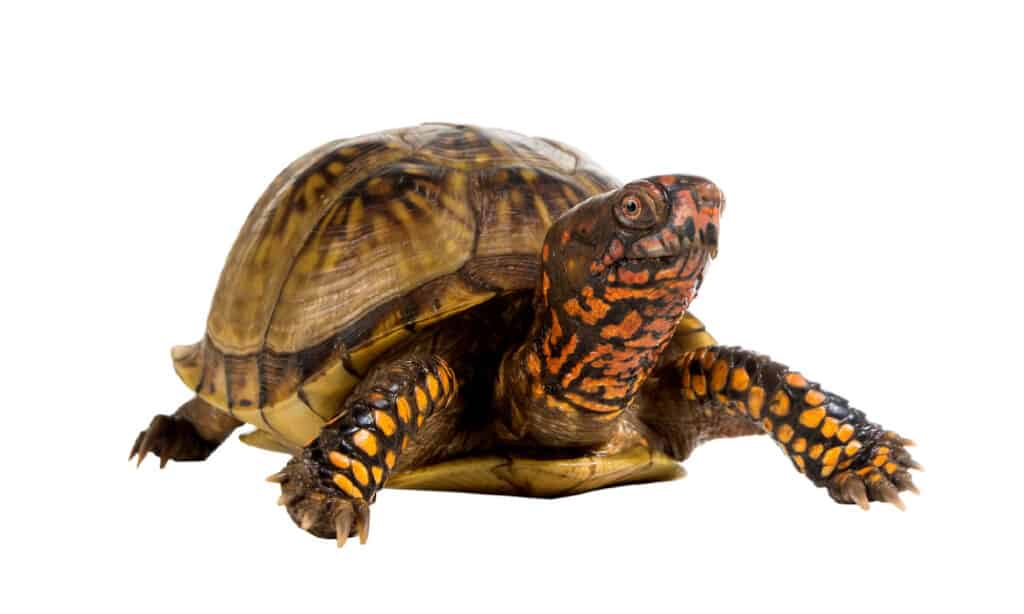
True to its name, the three-toed box turtle often has three toes on its back feet rather than the usual four.
©iStock.com/irin717
Of the four main species of box turtles, the three-toed box turtle is Louisiana’s most abundant variety. The species gets its name from the number of toes on its hind feet, though individuals with four toes are also common. It also differs from other types of box turtles thanks to the shape and positioning of its dark brown carapace, as the rear half is slightly taller than the front half.
Like all box turtles, the three-toed box turtle has a double-hinged plastron that is typically yellowish in color. The plastron’s hinges allow the turtle to tightly shut or “box” itself into its shell when threatened. This gives it a reliable defense against many predators despite being just 5 to 7 inches long on average.
As a mostly terrestrial species, the hardy three-toed box turtle prefers forested habitats with lots of leaf litter and vegetation, though it never strays far from water. Its thick, clawed feet are slightly webbed, though not nearly as prominently as more aquatic species like pond sliders and mud turtles.
Up Next:
The photo featured at the top of this post is © Kristian Bell/Shutterstock.com
Thank you for reading! Have some feedback for us? Contact the AZ Animals editorial team.






